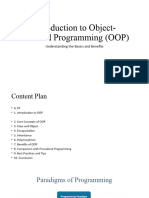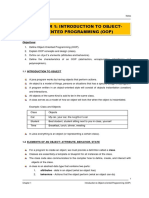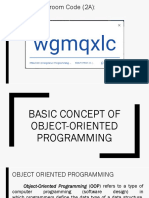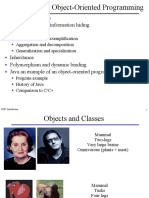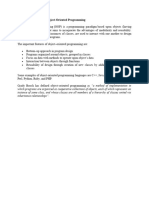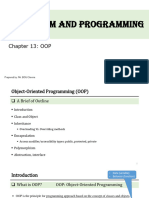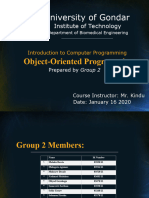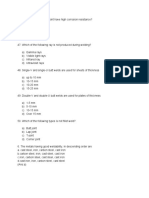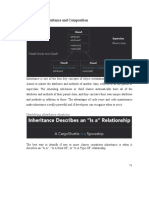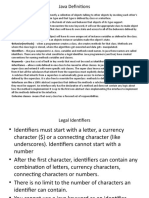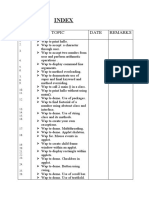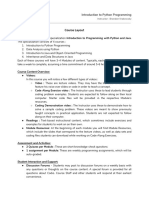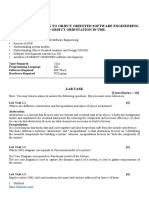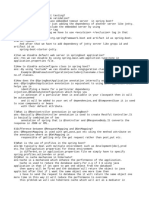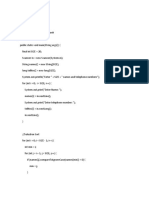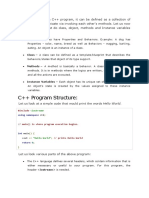Introduction to Object-Oriented Programming
Objects and classes
Encapsulation and information hiding
Mental exercises
Classification and exemplification
Aggregation and decomposition
Generalization and specialization
Inheritance
Polymorphism and dynamic binding
Java an example of an object-oriented programming language
Program example
History of Java
Comparison to C/C+
OOP: Introduction
�Objects and Classes
Mammal
Two-legs
Very large brains
Omnivorous (plants + meat)
Mammal
Tusks
Four legs
Herbivorous (plant eater)
OOP: Introduction
�The Object Concept
An object is an encapsulation of data.
An object has
identity (a unique reference)
state, also called characteristics (variables)
social security number (cpr), employee number, passport number
hungry, sad, drunk, running, alive
behavior (methods)
eat, drink, wave, smile, kiss
An object is an instance of an class.
A class is often called an Abstract Data Type (ADT).
OOP: Introduction
�The Class Concept
A class is a collection of objects (or values) and a
corresponding set of methods.
A class encapsulates the data representation and makes data
access possible at a higher level of abstraction.
Example 1: A set of vehicles with operations for starting,
stopping, driving, get km/liter, etc.
Example 2: A time interval, start time, end time, duration,
overlapping intervals, etc.
Example 3: A string, upper case, compare, lower case, etc.
str.equals(otherStr) class/Java style
strcmp(str, otherStr) C style
OOP: Introduction
�Encapsulation and Information Hiding
Data can be encapsulated such that it is invisible to the
outside world.
Data can only be accessed via methods.
Data
OOP: Introduction
send
message
Data
Function
Method
Function
Method
Function
Method
Procedural
Class
�Encapsulation and Information Hiding, cont.
What the outside world cannot see it cannot depend on!
The object is a fire-wall between the object and the outside
world.
The hidden data and methods can be changed without
affecting the outside world.
Outside world
An object
Client interface
Visible data and methods
Hidden (or encapsulated) data and methods
OOP: Introduction
�Class vs. Object
Class
A description of the
common properties of a
set of objects.
A concept.
A class is a part of a
program.
Object
A representation of the
properties of a single
instance.
A phenomenon.
An object is part of data
and a program execution.
Example 1: Person
Example 1: Bill Clinton,
Example 2: Album
OOP: Introduction
Bono, Viggo Jensen.
Example 2: A Hard Day's
Night, Joshua Tree, Rickie
Lee Jones.
7
�Connection between Object and Class
In object-oriented programming we write classes
The text files we create contain classes!
Static
One
Objects are created from classes
A class contains a receipe on how to make objects
Dynamic
Many
Ingrediens
250 g digestive biscuits food processor
125 g soft brown sugar saucepan
125 g butter wooden spoon
50 g raisins 18 cm sandwich tin (greased)
3 tablespoons cocoa powder fridge
1 egg, beaten knife
25 g = 1 oz
2.5 cm = 1 inch
Process
blend
bake
OOP: Introduction source http://www.icbl.hw.ac.uk/ltdi/cookbook/chocolate_cake/
source http://www.filflora.com
�Type and Interface
An object has type and an interface.
Account
balance()
withdraw()
deposit()
To get an object
To send a message
OOP: Introduction
Type
Interface
Account a = new Account()
Account b = new Account()
a.withdraw()
b.deposit()
a.balance()
9
�Instantiating Classes
An instantiation is a mechanism where objects are created
from a class.
Always involves storage allocation for the object.
A mechanism where objects are given an initial state.
Static Instantiating
In the declaration part of a
program.
A static instance is
implicitly created
OOP: Introduction
Dynamic Instantiating
In the method part of a
program.
A dynamic instance is
created explicitly with a
special command.
10
�Interaction between Objects
Interaction between objects happens by messages being send.
A message activates a method on the calling object.
An object O1 interacts with another object O2 by calling a
method on O2 (must be part of the client interface).
O1 sends O2 a message
O1 and O2 must be related to communicate.
The call of a method corresponds to a function (or procedure)
call in a non-object-oriented language such as C or Pascal.
O1
message
OOP: Introduction
message
O3
O2
message
11
�Phenomenon and Concept
A phenomenon is a thing in the real world that has
individual existence.
an object
A concept is a generalization, derived from a set of
phenomena and based on the common properties of these
phenomena.
a class
Characteristics of a concept
A name
Intension, the set of properties of the phenomenon
Extension, the set of phenomena covered by the concept.
OOP: Introduction
12
�Classification and Exemplification, Examples
hat, 23, 34, mouse, telephone, book, 98, 45.34, hello
numbers:
words:
23, 34, 98, 45.34
hat, mouse, telephone, book, hello
mouse, tyrannosaurus rex, allosaurus, elephant, velociraptor
dinosaur:
mammal:
OOP: Introduction
tyrannosaurus rex, allosaurus, velociraptor
mouse, elephant
13
�Classification and Exemplification, cont.
A classification is a description of which phenomena that
belongs to a concept.
An exemplification is a phenomenon that covers the concept
Concept
classification
exemplification
Phenomenon
OOP: Introduction
14
�Aggregation and Decomposition, Example
Idea: make new objects by combining existing objects.
Reusing the implementation!
Engine
start()
stop()
Gearbox
up()
down()
Door
open()
close()
existing classes
Car
Aggregation
Engine
Gearbox
Doors[4]
start()
drive()
new class
Car has-a Gearbox and Car has-an Engine
OOP: Introduction
15
�Aggregation and Decomposition
An aggregation consists of a number of (sub-)concepts which
collectively is considered a new concept.
A decomposition splits a single concept into a number of
(sub-)concepts.
Concept
Concept Concept Concept
decomposition
aggregation
Concept Concept Concept
Concept
OOP: Introduction
16
�Generalization and Specialization
OOP: Introduction
source : www.geology.ucdavis.edu/ ~GEL12/dinosauria.Html
17
�Generalization and Specialization, cont.
Generalization creates a concept with a broader scope.
Specialization creates a concept with a narrower scope.
Reusing the interface!
Concept A
Concept C
specialization
generalization
Concept B
Concept D
Vehicle
Car
Hatchback
OOP: Introduction
Station car
Truck
Sedan
Pickup
18
�Generalization and Specialization, Example
Inheritance: get the interface from the general class.
Objects related by inheritance are all of the same type.
Shape
draw()
resize()
Circle
draw()
resize()
Line
draw()
resize()
Rectangle
draw()
resize()
Square
draw()
resize()
Square is-a Shape or Square is-like-a Shape
OOP: Introduction
19
�Generalization and Specialization in Java
Object
clone()
equals()
toString()
...
Shape
draw()
resize()
Circle
OOP: Introduction
Line
Rectangle
20
�Polymorphism and Dynamic Binding
void doSomething(Shape s){
s.draw(); // magically calls the specific class
s.resize();
}
Circle c = new Circle();
Line l = new Line();
Rectangle r = new Rectangle();
doSomething(c);
doSomething(l);
doSomething(r);
// dynamic binding
Polymorphism: One piece of code works with all shape
objects.
Dynamic binding: How polymorphism is implemented.
OOP: Introduction
21
�Benefit Generalization and Specialization
Take previous Shape class hierarchy
remove inheritance
remove general and abstract class Shape
OOP: Introduction
Rectangle
draw()
resize()
Square
draw()
resize()
Circle
draw()
resize()
Line
draw()
resize()
22
�Code Example, Revisited
void doSomething(Circle c){
c.draw();
c.resize();
}
void doSomething(Line l){
l.draw();
l.resize();
}
Circle c = new Circle();
Line l = new Line();
Rectangle r = new Rectangle();
doSomething(c);
doSomething(l);
doSomething(r);
OOP: Introduction
void doSomething(Rectangle r){
r.draw();
r.resize();
}
void doSomething(Square s){
s.draw();
s.resize();
}
Similar code
is repeated
23
�Java Program Structure
// comment on the class
public class MyProg {
String s = Viggo;
/**
* The main method (comment on method)
*/
public static void main (String[] args){
// just write some stuff
System.out.println ("Hello World"); }
variable
method header
method body
OOP: Introduction
24
�Java Class Example Car
/** A simple class modeling a car. */
public class Car {
// instance variables
private String make;
private String model;
private double price;
// constructor
public Car(String m, String mo, double p) {
make = m; model = mo; price = p;
}
// string representation of the car
public String toString() {
return "make: " + make + " model: "
+ model + " price: " + price;
}
}
OOP: Introduction
25
�Byte Code vs. Executable
MyProg.java
MyProg.cpp
javac MyProg.java
gcc MyProg.cpp
-o myprog.exe
Java Class File
MyProg.class
Portable Byte Code
Java Virtual Machine
Executable myprog.exe
Operating System
Operating System
Java/C# world
C++ world
OOP: Introduction
26
�History of Java
1990 Oak (interactive television, big failure)
1994 Java (for the Internet)
Main feature: "Write Once, Run Any Where"
=> wrap the operating system so they all look the same
Designed for
A fresh start (no backward compatibility)
Pure OOP: C++ Syntax, Smalltalk style
Improvements over C++ much harder to write a bad program
Internet programming
Very hard to create a virus
Run in a web browser (and at the server)
There is a speed issue (from Java 1.3 and up much better)
C# Microsoft's Java-Killer project release 2001
Language very similar to Java
Commen-Language Runtime (CLR) supports 30+ languages
OOP: Introduction
27
�Difference from C/C++
Everything resides in a class
variables and methods
Garbage collection
bye bye malloc(), free(), and sizeof()
Error and exception handling handling
No global variables or methods
No local static variables
No separation of declaration and implementation
Bye bye header files
No explicit pointer operations (uses references)
No preprocessor (but something similar)
Has fewer dark corners
Has a much larger standard library (Java Developer Kit or
JDK)
OOP: Introduction
28
�Summary
Classes are recipes for creating objects
All objects are instances of classes
Encapsulation
Key feature of object-oriented programming
Separation of interface from implementation
It is not possible to access the hidden/encapsulated parts of an object
Aggregation and decomposition
has-a relationship
Generalization and specialization (inheritance)
is-a or is-like-a relationship
Polymorpishm/dynamic binding
Softening static typing
OOP: Introduction
29
�Common Mistakes and Errors
// what is ugly here?
public class main {
public static void main(String[] args){
System.out.println(Hello World);}
}
// what is wrong here?
public class MyClass {
public void static main(string[] args){
system.out.println(Hello World);}
}
// what is ugly here?
public class MyClass {
public static void main(String[] args){
System.out.println(Hello World);}
};
OOP: Introduction
30
�Structuring by Program or Data?
What are the actions of the program vs. which data does the
program act on.
Top-down: Stepwise program refinement
Bottom-up: Focus on the stable data parts then add methods
Object-oriented programming is bottom-up. Programs are
structure with outset in the data.
C and Pascal programs are typically implemented in a more top-down
fashion.
OOP: Introduction
31
�Pure Object-Oriented Languages
Five rules [source: Alan Kay]
Everything in an object.
A program is a set of objects telling each other what to do by
sending messages.
Each object has its own memory (made up by other objects).
Every object has a type.
All objects of a specific type can receive the same messages.
Java breaks some of these rules in the name of efficiency.
OOP: Introduction
32










